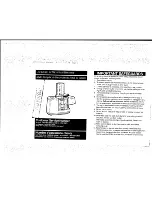
Installation and Operation, cont’d
USP 405 • Installation and Operation
2-10
8
.
View the horizontal phases again. If the phase difference is not zero,
repeat steps 6 and 7 until the settings do not change.
9
.
Once the settings are stable, disconnect the oscilloscope, and reconnect
the genlock cables.
10
. Check the display(s) for proper colors and for undesirable artifacts in
the image(s). Make adjustments as necessary.
11
. If other USP 405s are part of this genlock daisy chain, connect the
oscilloscope to each device, and repeat this procedure.
Oscilloscope displays
What you see on the oscilloscope while adjusting the USP 405 to match the
genlock signal depends on the type of signal used, the type of oscilloscope, and
the procedure the scope requires. This section shows some examples of
oscilloscope displays.
The following diagram shows the genlock input signal (top) and an out-of-
alignment NTSC composite sync output signal (bottom) displayed on a
waveform monitor to check for alignment. When the phases are aligned, the
wave peaks on the bottom waveform should line up with those in the reference
signal above it.
Superimposed waveforms
With this method there is no way to know if the signals are 180º out of phase. A
delayed sweep on a time-based scope would allow a more accurate display of the
input and output signal phase relationships.
A vectorscope is more accurate than a waveform monitor. The following diagram
shows an example of a vectorscope display when the horizontal phase is
adjusted to align it with the burst (genlock) vector. Adjust the horizontal phase
by rotating the horizontal Adjust (
)
knob until the difference between the two
vectors is 0º. This example shows black burst only (with no color). The burst
vector is pointing to the left from the center.
im Vertrieb von
CAMBOARD Electronics
www.camboard.de
Tel. 07131 911201
Fax 07131 911203














































